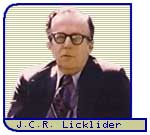 |
|||
 |
|||
In the 1950s, the new field of computer science was
introduced on university campuses around the country. MIT was one of
the early leaders in the field, and researcher at MIT's Lincoln Lab had
access to several mainframe computers. Lincoln Lab also built their own
computers including the TX-0 (the first transistorized computer, thus the
"T") and TX-2. Both of the TX computers were built by two MIT technicians,
Ken Olsen (the founder of Digital Systems) and Wesley Clark.
An MIT psychoacoustrician named J.C.R. Licklider took
and immediate and intense interest in computer after Clark demonstrated
the TX-0 to him.
In 1960,
Licklider wrote a landmark article
titled "Man-Computer
Symbiosis". In his article Licklider looked beyond the conventional
idea that computers were mere calculators. He saw a relationship with
computers where people "will set the goals, formulate the hypotheses,
determine the criteria, and perform the evaluation." The computer would
take care of the tedious work and allow us to do the important stuff.
Intergalactic
Network
In 1962, Jack Ruina, the director of ARPA, offered Licklider the chance to
start ARPA's new behavioral science division, and because Licklider was
interested in computer science, the new Information Processing Techniques
Office as well. It was an opportunity for Licklider to blend his background
in psychology and his interest in computers together.
![]() Lick
Lick
 Licklider, called "Lick" by his friends and fellow researchers, applied
his background in psychology to research how people interacted with
computers, and he became known as an expert in human-computer interaction.
People at ARPA took notice and offered Licklider the job of director
for their new Information Processing Techniques Office (IPTO). He accepted
the position as the founding director and continued his research in
human-computer interaction.
Licklider, called "Lick" by his friends and fellow researchers, applied
his background in psychology to research how people interacted with
computers, and he became known as an expert in human-computer interaction.
People at ARPA took notice and offered Licklider the job of director
for their new Information Processing Techniques Office (IPTO). He accepted
the position as the founding director and continued his research in
human-computer interaction.
Licklider observed how the researchers and students at the Lincoln Lab communicated with each other on time-sharing computers. He theorized that computers augmented human thinking by increasing their ability to communicate. If the whole world, he proposed, could connect through a "intergalactic network" they could share ideas and collaborate in an integrated unit. However, he had no idea how to create this global network.
Copyright © 1998, PBS Online,
Inc. All Rights Reserved.
Site Designed and Developed by
OPB Learning Media